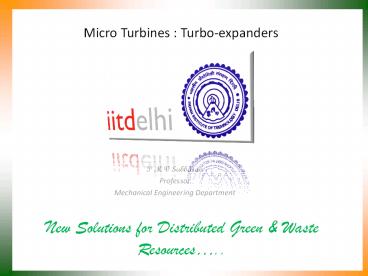Micro Turbines : Turbo-expanders - PowerPoint PPT Presentation
1 / 32
Title:
Micro Turbines : Turbo-expanders
Description:
Micro Turbines : Turbo-expanders P M V Subbarao Professor Mechanical Engineering Department New Solutions for Distributed Green & Waste Resources .. – PowerPoint PPT presentation
Number of Views:230
Avg rating:3.0/5.0
Title: Micro Turbines : Turbo-expanders
1
Micro Turbines Turbo-expanders
P M V Subbarao Professor Mechanical Engineering
Department
New Solutions for Distributed Green Waste
Resources..
2
Selection of An Expander
3
In search of A Suitable Principle of Momentum
Exchange/Direction of Fluid Flow
- Primary characteristics of a source or need.
- The cause/effect Dp or Dh
- The Capacity Flow rate, Q (m3/s ).
- Density of fluid r(kg/m3).
4
Time Scale of a Machine to Resource
Speed N (rpm) or n (rps) of a turbo machine
This is named as Specific Speed, Ns
5
Selection of An Expander
6
Why Radial Flow Turbines
- Better ability to guide flow in an optimal
direction into the expansion turbine wheel, - Variable inlet guide vanes present the most
important advantage of a radial turbine over an
axial turbine. - Suitable for highly variable natural sources of
energy/waste energy recovery.
7
Turbo-Expanders
8
Compressible Flow Francis Turbine
- Through minor modifications standard radial
inflow turbines can be optimized for different
renewable thermal resources. - They enable to smooth the seasonal variations by
maintaining high efficiency levels at off-design
conditions through the use of variable inlet
guide vanes. - Radial inflow turbines are less sensitive to
blade profile in accuracies than axial turbines,
which enable high efficiencies to be maintained
as size decreases. - Radial-inflow turbines are more robust under
increased blade road caused by using high-density
fluids as either subcritical or supercritical
conditions.
9
Compressible Flow Francis Turbine
- Radial inflow turbines are easier to manufacture
relative to axial turbines as the blades are
attached to the hub. - The rotor dynamic stability of the system is also
improved due to a higher stiffness.
10
Parts of A Turbo-expander
11
Design of Spiral Casing
Select a suitable value of mass flow rate.
12
At any angle q, the radius of casing is
A full spiral is generally recommended for high
head 300m, semi-spiral is recommended for low
head lt 50m.
In general k 1.0, however corrected using CFD.
13
Flow Distribution Analysis of Casing
Stay vanes or Guide vanes
14
Parts of A Turbo-expander
15
Geometrical Description of A Turbo-expander
16
Water particle
Water from spiral casing
17
Design of the Details of Stay Vanes
Theory of Relatively Whirling flow
Besv
18
Runner inlet (F 0.870m)
Guide vane outlet for designa) (F 0.913m)
Closed Position
Max. Opening Position
19
Operation of Guide Vanes
.
20
Design of the Guide Vanes
- The outlet angle can be calculated by assuming a
vortex from the flow in the gap between the
runner and the guide vanes
Select appropriate value of n
21
The correlation between the turbinedischarge and
the guide vane opening angle.
22
Pressure drop versus guide vane angle
23
Velocity triangles
24
Inlet Velocity Triangles Vs Ns
Low Specific Speed Slow Francis Runner
25
Inlet Velocity Triangles Vs Ns
Low Specific Speed Normal Francis Runner
26
Inlet Velocity Triangles Vs Ns
High Specific Speed Fast Francis Runner
27
Specfic Speed Vs Runner Shape
28
3D Reconstruction of Runner with Blades
29
Study of Velocity distribution on runner for
improvement
30
Design Rule 1
31
Design Rule 2
32
Design Rule 3































